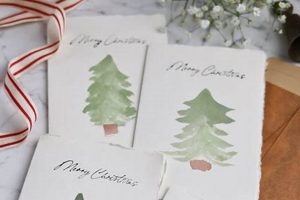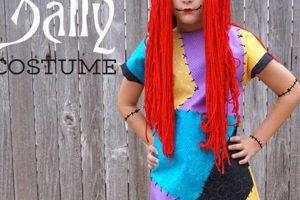The activity involves customizing a standard garment, often a sweatshirt or knitted sweater, with festive decorations. These embellishments range from simple glued-on elements like felt shapes and pom-poms to more complex additions involving sewing, embroidery, or even light-emitting diodes (LEDs). An example might be attaching miniature jingle bells and a felt reindeer to a plain red sweater.
Creating personalized holiday apparel allows for self-expression and participation in seasonal celebrations without incurring significant expense. Furthermore, the practice provides an opportunity for creative engagement and can become a shared activity for families or groups. The trend has roots in the broader movement of handcrafted items and personalized fashion, gaining increased popularity with the rise of social media and online tutorials.
The following sections will explore specific techniques for embellishment, considerations for material selection, safety guidelines for incorporating certain elements, and inspirational design ideas for crafting unique and memorable holiday attire.
Guidance for Crafting Festive Holiday Apparel
The following recommendations are designed to optimize the process of producing customized seasonal garments, ensuring both aesthetic appeal and structural integrity.
Tip 1: Design Prioritization: Before commencing physical alterations, a detailed design should be finalized. This blueprint clarifies the placement of embellishments and avoids potential rework.
Tip 2: Material Compatibility: Adhesives and fabrics must be tested for compatibility to prevent detachment or discoloration. A small, inconspicuous area should be used for initial testing.
Tip 3: Secure Attachment: When applying embellishments, ensure a robust and lasting bond. Sewing is recommended for heavier or frequently used elements, while fabric glue may suffice for lighter decorations.
Tip 4: Proportionate Embellishment: Maintain a balance between the base garment and the additions. Overcrowding can detract from the overall aesthetic and reduce wearability.
Tip 5: Comfort Considerations: When attaching items, prioritize comfort. Avoid placing bulky or rigid elements in areas of high friction or movement.
Tip 6: Safe Illumination: If incorporating LEDs, use low-voltage options and ensure proper insulation to prevent electrical hazards. Battery packs should be securely fastened and easily accessible for replacement.
Tip 7: Color Harmony: Choose a cohesive color palette. Limit the number of contrasting colors to maintain a visually appealing design. A maximum of three primary colors is generally recommended.
Adherence to these guidelines facilitates the creation of garments that are both visually engaging and structurally sound, suitable for repeated wear during the holiday season.
The subsequent section will address potential challenges encountered during the creation process and strategies for effective problem-solving.
1. Creativity
Creativity serves as the foundational element in the realm of customized holiday apparel. It transcends mere replication of established designs, fostering innovation and individual expression in the context of seasonal attire.
- Novelty in Design
Novelty in design involves moving beyond traditional Christmas imagery such as Santa Claus or reindeer. It encourages the incorporation of unconventional themes, unexpected color combinations, or the integration of personal interests into the garments aesthetic. For instance, a scientist might incorporate elements of chemistry into a holiday-themed design, or a musician could integrate musical notes and instruments. This aspect of creativity results in garments that are unique and reflective of the wearer’s identity.
- Material Experimentation
Material experimentation refers to the application of non-traditional materials in the creation of the garment. This could involve utilizing recycled materials, integrating textures through the use of unconventional fabrics like burlap or felt, or incorporating three-dimensional elements crafted from unexpected sources like bottle caps or wire. Experimentation with materials introduces an element of surprise and visual interest, enhancing the garment’s tactile and aesthetic qualities.
- Technique Innovation
Technique innovation focuses on the application of novel embellishment methods beyond simple gluing or sewing. This could involve techniques such as fabric painting, tie-dyeing, embroidery, or even the incorporation of electronic elements like LEDs. Innovation in technique allows for greater control over the design and provides opportunities to create complex and dynamic visual effects. Examples include using stencils to create intricate patterns or incorporating conductive thread to create interactive elements.
- Humorous Interpretation
Humorous interpretation involves injecting humor and wit into the design, subverting traditional holiday motifs or creating playful visual puns. This can range from subtly altering existing images to creating entirely original comedic scenes. The addition of humor can make the garment more engaging and memorable, differentiating it from more conventional holiday attire. Examples include a sweater featuring a reindeer tangled in Christmas lights or a snowman melting in a beach chair.
The integration of these creative facets elevates the crafting of customized holiday apparel from a simple activity to a form of artistic expression. By embracing novelty, experimentation, innovation, and humor, individuals can create garments that are not only festive but also personal statements, reflecting their unique perspectives and skills.
2. Originality
Originality in the context of customized holiday apparel represents a departure from mass-produced, commercially available options. It emphasizes the creation of unique items that reflect individual creativity and diverge from standardized designs.
- Uniqueness of Concept
This facet pertains to the underlying theme or idea that informs the garment’s design. Rather than replicating popular holiday characters or scenes, the concept should present a novel perspective or interpretation. For instance, instead of a traditional snowman, the design could feature a snowman engaged in an unusual activity, or incorporate elements from a specific hobby or interest. The aim is to produce an item that is recognizably individual.
- Distinctiveness of Execution
Distinctiveness of execution refers to the techniques and materials employed in the garment’s creation. This involves moving beyond common embellishment methods and incorporating unconventional materials or approaches. Examples include using upcycled materials, employing advanced embroidery techniques, or integrating interactive electronic elements. The execution should set the piece apart from standard, readily available alternatives.
- Personal Narrative Integration
The integration of a personal narrative involves incorporating elements that reflect the individual’s experiences, memories, or affiliations. This could involve using specific colors, symbols, or imagery that hold personal significance. For instance, a garment could feature the colors of a favorite sports team or incorporate elements that evoke a cherished childhood memory. This imbues the piece with a unique and personal character.
- Subversion of Expectations
Subversion of expectations involves challenging traditional holiday conventions or themes. This could involve incorporating humor, irony, or unexpected juxtapositions. For example, a garment might feature a traditionally festive character in an unconventional setting or situation, creating a surprising and memorable visual impact. The goal is to create a piece that is both visually engaging and thought-provoking.
The commitment to originality in customized holiday apparel results in garments that are not only visually appealing but also imbued with personal meaning and creative expression. These items serve as tangible representations of individual identity and artistic vision, standing in contrast to the homogeneity of commercially produced alternatives.
3. Festiveness
Festiveness, in the context of customized holiday apparel, is the quality that evokes the spirit and atmosphere of the Christmas season. It encompasses visual and thematic elements designed to elicit feelings of joy, celebration, and goodwill, central to the purpose and appeal of a self-made seasonal garment.
- Thematic Representation
Thematic representation involves the direct incorporation of traditional Christmas symbols, imagery, and motifs. This includes elements such as Santa Claus, reindeer, snowmen, Christmas trees, and ornaments. The effective use of these symbols immediately establishes the garments festive intent and connects it to widely recognized holiday traditions. For example, a sweater featuring a meticulously crafted felt Christmas tree adorned with sequin ornaments clearly communicates a festive theme. The appropriate selection and arrangement of these elements are crucial to conveying the intended message of celebration.
- Color Palette Utilization
Color palette utilization centers on the strategic deployment of colors associated with the Christmas season. Predominantly, this includes the use of red, green, gold, and silver. These colors are deeply embedded in cultural representations of Christmas and contribute significantly to the overall festive aesthetic. A garment incorporating these colors, whether through fabric choice or embellishment, inherently resonates with the holiday spirit. For example, a sweater featuring a green background with red and gold accents evokes a classic Christmas color scheme, enhancing its festiveness. The specific shades and combinations chosen can further refine the desired tone, ranging from traditional to modern interpretations.
- Textural Embellishment
Textural embellishment refers to the incorporation of tactile elements that enhance the garments visual and sensory appeal. This includes the use of materials such as faux fur, pom-poms, jingle bells, and glitter. These elements introduce a multi-sensory dimension to the design, contributing to a heightened sense of festiveness. For example, a sweater adorned with fluffy white pom-poms to simulate snow evokes a tactile and visually engaging representation of winter. The strategic placement and selection of these materials can significantly impact the overall aesthetic and contribute to a more immersive festive experience.
- Illumination Integration
Illumination integration involves the incorporation of light-emitting elements, such as LEDs or fiber optics, to create dynamic visual effects. These elements introduce a sense of movement and dynamism, enhancing the garment’s visual appeal and capturing attention. A sweater featuring twinkling LED lights embedded within a Christmas tree design adds a layer of visual interest and festiveness. The careful selection and placement of these elements, along with appropriate power sources and safety considerations, are essential for achieving the desired effect while maintaining user safety.
Collectively, these facets contribute to the creation of customized holiday apparel that effectively embodies the spirit of Christmas. The judicious combination of thematic representation, color palette utilization, textural embellishment, and illumination integration results in garments that are visually engaging, emotionally resonant, and deeply connected to the traditions and celebrations associated with the holiday season.
4. Personalization
The creation of customized holiday garments fundamentally incorporates the element of personalization, a crucial factor that distinguishes these items from commercially manufactured alternatives. The deliberate injection of individual preferences, interests, and memories transforms a generic article of clothing into a unique and meaningful expression. This process begins with the selection of base materials and extends through the application of embellishments, reflecting the creator’s distinct vision. The direct result of this personalization is a garment that serves not only as festive attire but also as a tangible representation of individual identity.
One significant benefit of incorporating personalization lies in its capacity to create garments that resonate on a deeper emotional level. For example, a family might collaborate on a collection of sweaters, each incorporating elements that represent a shared memory or inside joke. This collaborative effort enhances the garments sentimental value, transforming them into treasured keepsakes. Moreover, the ability to tailor the design to specific individual preferences, such as color choices, thematic elements, or even the inclusion of personalized monograms, ensures that the resulting garment aligns perfectly with the wearer’s aesthetic sensibilities. This degree of customization is rarely, if ever, achievable with mass-produced items.
Understanding the role of personalization in the context of customized holiday apparel is essential for appreciating its significance beyond mere ornamentation. It is the driving force behind the creation of items that are both visually appealing and deeply meaningful, fostering a sense of connection and individual expression. While challenges may arise in executing complex designs or sourcing specific materials, the resulting garment offers a unique and lasting expression of personal identity and creativity, embodying the spirit of the holiday season in a tangible and personal way.
5. Affordability
The appeal of crafting customized holiday sweaters is significantly linked to the economic advantages it presents. Creating one’s own festive garment mitigates the need to purchase often overpriced, commercially available alternatives. The financial savings stem from leveraging existing materials or acquiring inexpensive craft supplies, thereby reducing the overall expenditure. This cost-effectiveness is particularly relevant in situations where multiple garments are required, such as for families or groups participating in holiday-themed events. For instance, producing five customized sweaters for a family could be substantially cheaper than buying five equivalent items from a retail store.
The specific materials employed in the creation process directly influence the overall cost. The utilization of recycled fabrics, repurposed decorations, and readily accessible craft supplies further contributes to affordability. Simple embellishments like felt cutouts, pom-poms, and adhesive glitter can be obtained at minimal expense, enabling the creation of visually appealing garments without a substantial financial investment. Moreover, the application of basic sewing or gluing techniques allows individuals with limited crafting experience to participate, expanding the activity’s accessibility. A practical example includes transforming an old sweatshirt into a festive garment through the addition of simple felt shapes and fabric glue, incurring a total cost of only a few dollars.
In summary, the creation of customized holiday apparel offers a cost-effective alternative to purchasing commercially produced items. The ability to control material costs, leverage existing resources, and employ simple crafting techniques contributes to its affordability. While challenges may arise in sourcing specific embellishments or executing complex designs, the overall economic benefits remain a key factor in the activity’s widespread appeal, making festive attire accessible to a broader segment of the population. The affordability empowers individual to engage in unique expression without overspending.
6. Memorability
The crafting and wearing of customized holiday sweaters possess the inherent capacity to generate lasting memories. This effect stems from the unique combination of personal investment, shared experiences, and visual distinctiveness associated with the activity. The creation process itself, involving design choices, material selection, and collaborative effort, often becomes a significant event, fostering a sense of accomplishment and bonding. The resulting garments, unlike mass-produced items, serve as tangible reminders of these moments, triggering specific recollections each time they are worn or viewed. For example, a family that collaboratively designs sweaters annually may associate the garments with specific holiday seasons, marking significant life events or personal milestones during those years.
The visual uniqueness of these garments further contributes to their memorability. Unlike generic holiday attire, customized sweaters often incorporate personal themes, inside jokes, or distinctive design elements that set them apart. This distinctiveness makes them more readily recalled and associated with specific occasions or individuals. A sweater featuring a recurring family joke or an unusual color combination, for instance, may become inextricably linked to particular holiday gatherings or events. Furthermore, the act of wearing these garments in public settings generates interactions and comments, creating additional layers of recollection and reinforcing their memorable quality. The garments, therefore, serve as visual cues, triggering specific memories and associations linked to the individuals and events surrounding their creation and use.
In conclusion, the memorability associated with customized holiday sweaters arises from the confluence of personal investment, shared experiences, and visual distinctiveness. The garments become more than mere articles of clothing; they transform into tangible representations of cherished moments and personal connections. While challenges may arise in preserving these garments over time, the enduring memories they evoke render them valuable keepsakes, embodying the spirit of the holiday season and the bonds between individuals. The practical significance of understanding this connection lies in recognizing the potential of these garments to foster a sense of continuity and tradition, strengthening emotional bonds and creating lasting legacies.
Frequently Asked Questions Regarding Customized Holiday Apparel
The following section addresses common inquiries and misconceptions surrounding the creation and maintenance of personalized Christmas garments, providing clarity and guidance for individuals interested in engaging with this activity.
Question 1: What are the primary challenges encountered when crafting a unique holiday sweater?
The creation process often presents challenges related to design execution, material selection, and structural integrity. Translating a conceptual design into a tangible product requires careful planning and technical skill. Identifying compatible materials that adhere properly and withstand repeated wear can be problematic. Ensuring that embellishments are securely attached to the base garment to prevent detachment is also a significant concern.
Question 2: What are the recommended base garments for customization?
The selection of a suitable base garment is crucial for the final product’s success. Sweatshirts and knitted sweaters are commonly employed due to their structural properties and availability. The chosen garment should possess a relatively smooth surface to facilitate the secure attachment of embellishments. Consideration should also be given to the garment’s weight and fiber content, as these factors influence its comfort and durability.
Question 3: What types of embellishments are appropriate for customized holiday attire?
A wide range of embellishments can be incorporated, including felt shapes, pom-poms, sequins, beads, fabric paint, and even electronic components. The selection of embellishments should be guided by the overall design aesthetic, the desired level of complexity, and the individual’s skill level. Consideration must be given to the embellishments’ weight, size, and attachment method to ensure both visual appeal and structural stability.
Question 4: What are the safety precautions to observe when incorporating electronic elements?
The integration of electronic components, such as LEDs, requires adherence to stringent safety protocols. Low-voltage components should be utilized to minimize the risk of electrical shock. All wiring and connections must be properly insulated to prevent short circuits. Battery packs should be securely fastened and easily accessible for replacement. It is imperative to conduct thorough testing to ensure the safe and reliable operation of all electronic elements before wearing the garment.
Question 5: What cleaning and maintenance procedures are recommended?
The cleaning and maintenance of customized holiday garments require careful attention to prevent damage to the embellishments. Hand washing is generally recommended to minimize the risk of detachment or discoloration. Harsh detergents and abrasive cleaning agents should be avoided. The garment should be air-dried flat to prevent stretching or distortion. Spot cleaning can be employed to address localized stains or spills.
Question 6: How can one ensure the long-term preservation of a handcrafted holiday garment?
Proper storage is essential for the long-term preservation of customized holiday attire. The garment should be stored in a cool, dry location, away from direct sunlight. It should be folded carefully or hung on a padded hanger to prevent creasing or distortion. Moth repellent should be utilized to protect the garment from insect damage. Periodic inspection and cleaning can help maintain its appearance and structural integrity over time.
In summary, successful creation and preservation depend on careful planning, technique, and material selection.
The following section will address potential challenges encountered during the creation process and strategies for effective problem-solving.
Conclusion
This exploration has underscored the multifaceted nature of the diy christmas sweater. Beyond its superficial role as festive attire, the activity fosters creativity, promotes personalization, and offers an affordable alternative to commercially manufactured goods. The generation of lasting memories further enhances the value of these handcrafted items, transforming them into tangible expressions of individual identity and shared experiences. The technical aspects, including design, material selection, and safe embellishment techniques, demand careful consideration to ensure both aesthetic appeal and structural integrity.
The enduring appeal of the diy christmas sweater lies in its capacity to blend self-expression with seasonal celebration. Continued innovation in crafting techniques and material utilization will likely sustain the activity’s popularity. Individuals are encouraged to approach this endeavor with thoughtful planning and a commitment to both creativity and safety, ensuring that the resulting garments serve as lasting emblems of holiday spirit.







